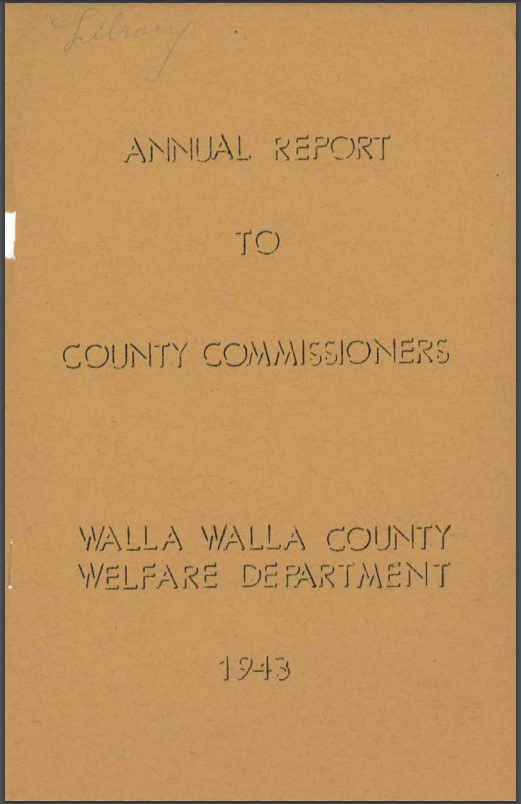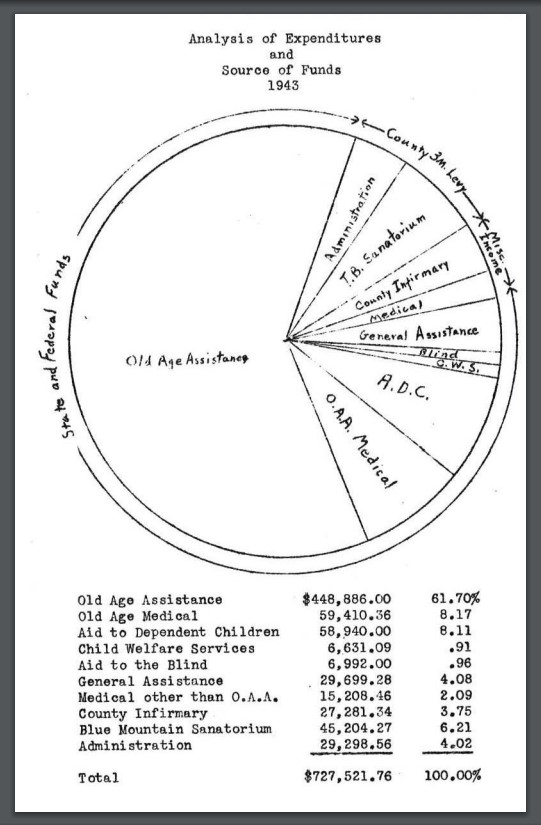
BEFORE FEDERAL SOCIAL-WELFARE PROGRAMS: WALLA WALLA COUNTY WELFARE DEPARTMENT ANNUAL REPORT TO COUNTY COMMISSIONERS, 1943
In the era before federal social-welfare programs, states and their individual counties had to do the job themselves. This effort is the focus of the Walla Walla County Welfare Department’s 1943 Annual Report to County Commissioners.

The report starts by listing the employee names of the department’s administrative unit and those assigned to various facilities and programs. Aside from the administrative unit, the report lists the Stone Creek Sanitarium, the Blue Mountain sanitarium, the Medical Aid program, and the Old Age Assistance benefits program.
Department Administrator Bernard Kirby then provided the reader a brief narrative of the department’s activities in the past year — including a surprisingly detailed consideration of social and budgetary trends — and laid out the department’s budget and staffing requirements in the coming year.
Kirby noted that the wartime economy led to shifting public assistance needs. High employment relieved some of the strain on the county for assistance to jobless men; Kirby noted the department had altered its emphasis to security for “the aged, for the blind, and for dependent children.” (pg. 5) He advised that the previous stigma attached to accepting public assistance “has largely vanished.” (pg. 5)
Kirby also commented on a substantial change in the way families took care of each other: “Many persons who are quite prosperous no longer feel any obligation to care for their dependent parents or other relatives…In fact our vocabulary has changed and clients, relatives, public officials, newspapers and sometimes welfare workers call the [public assistance] benefits ‘pensions.’” (pg. 5)
Kirby then shared a brief look at each of the programs administered by the Welfare Department. He noted that $5 out of every $6 spent by the department fell under the heading of Old Age Assistance. He further noted that there was a slight decline in the number of recipients during the two previous years — from 1,072 in 1942 to 1,069 in 1943. (Pg. 6) Children’s nutrition programs also saw a small decrease in recipients.
Annual facilities reports from Stone Creek Sanitarium (the County Infirmary) and Blue Mountain Sanitarium (the County Tuberculosis hospital) were included in the report, as was a lament on the difficulty of staffing programs when better-paying jobs abounded in the war industries.
Nearing the end of his narrative, Kirby wrote of the relatively new Social Security Act, passed in 1935, and its potential effect on the department. He hoped that the federal funding would match all county monies. “At present for example, state and/or county treasuries pay for all medical care given to recipients; approximately 70% of A.D.C. [Aid to Families with Dependent Children] costs.” (Pg. 22) Finally, in a series of graphs and pie charts, Kirby demonstrated the changing needs and sources of funding, with past budgets presented for comparison.


As a whole, the report presents a picture of a relatively small and rural county’s efforts to provide some sort of social safety net with only limited state financial assistance. It also tells the story of how urbanization and the massive economic turnaround of the war years after the Great Depression were changing the needs and the resources to meet those needs.
* * *
The image up top shows Second Avenue, looking North from Alder Street in Walla Walla, Wash. Source: Washington State Archives – Digital Archives.
A division of the Office of the Secretary of State, Washington State Archives collects and preserves the state’s historical records and makes them available to the public, including government agencies, researchers, historians, and journalists. With branches in Bellevue, Bellingham, Cheney, Ellensburg, and Olympia, the State Archives offers access to records for research and records-management education and training for local and state agency staff.